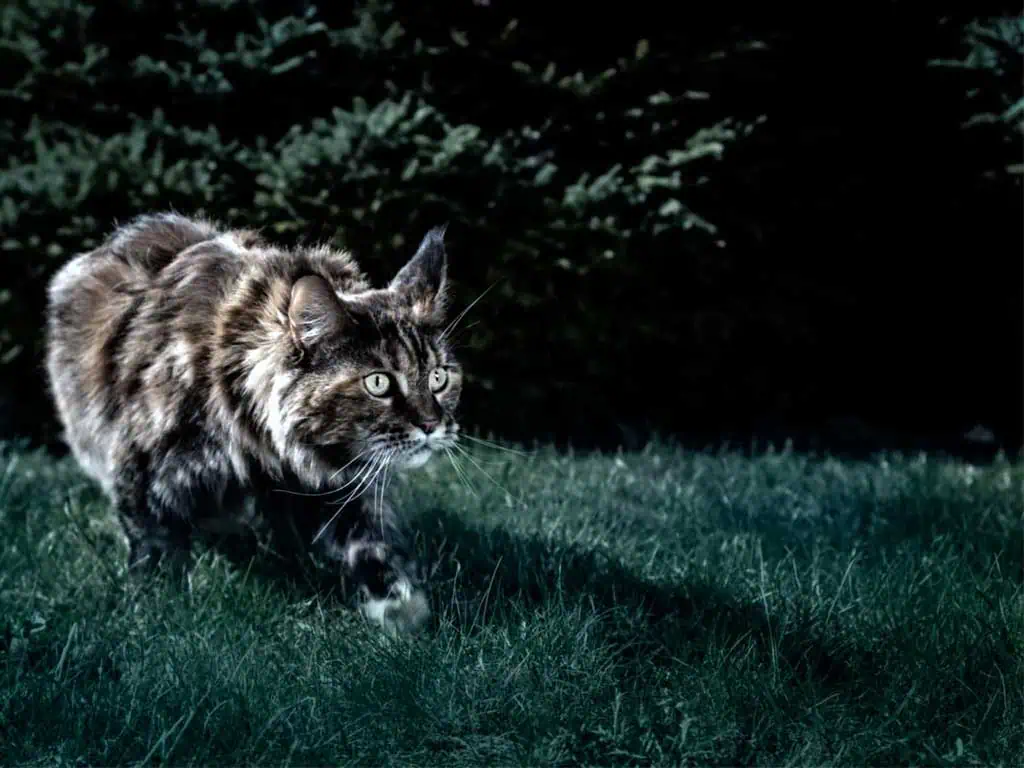
Cats have always been wrapped in a sense of mystery, especially when it comes to their ability to move gracefully in the dark. Pet owners often wonder: can cats see in the dark? The short answer is yes, but there’s much more to the story. Their eyes are fascinatingly complex, and understanding how feline night vision works can help you better care for your pet.
In this article, we’ll uncover 9 amazing secrets about cats and their night vision—from the science of their eyes to how you can support their nighttime instincts.
Table of Contents
Why Cat Eyes Are Built for the Dark
Cats evolved as crepuscular hunters, most active during dawn and dusk. Their eyes have adapted to maximize light intake, making them experts at navigating low-light environments. Unlike humans, cats have:
- Larger corneas and pupils relative to head size, allowing more light to enter.
- A tapetum lucidum, a reflective layer behind the retina that bounces light back through photoreceptors.
- A high ratio of rod cells (for dim-light vision) compared to cone cells (for color).
These adaptations don’t give them superhero powers, but they do explain why your cat can dart around a dark living room with ease while you’re fumbling for the light switch.
Can Cats See in the Dark Secret
Secret 1: Cats Don’t See in Total Darkness
A common myth is that cats have perfect night vision even in complete darkness. The truth? They still need some level of light. Their eyes amplify available light—moonlight, street lamps, or even the faint glow from electronics—but they cannot see in absolute pitch black.
Secret 2: Pupils Adjust Rapidly for Hunting
A cat’s pupils are vertical slits that can expand up to 300 times wider than in bright light. This quick dilation lets them adapt instantly to changes in lighting, making them stealthy hunters whether they’re chasing a toy at dusk or a bug at midnight.
Secret 3: The Tapetum Lucidum Creates “Glowing Eyes”
That eerie green or yellow glow you see in cat photos taken with flash? It’s caused by the tapetum lucidum reflecting light back out of the eye. This mirror-like layer effectively gives incoming photons a “second chance” to be detected, boosting night vision significantly.
Secret 4: Rod-Dominated Vision Boosts Low-Light Sight
Cats have about 6–8 times more rod cells than humans. Rods are specialized for detecting motion and light in dim conditions. This is why your cat might spot the tiniest movement in a dark corner that you completely miss.
Secret 5: Colors Look Different at Night
While cats see well in low light, they don’t perceive the same range of colors as humans. Their world is largely shades of blue and green, with reds and pinks appearing duller. In dim light, their color vision is even more restricted, but their ability to detect contrast and movement makes up for it.
Secret 6: Whiskers Aid Navigation in the Dark
Vision isn’t the only tool cats rely on at night. Their whiskers act as highly sensitive sensors, detecting air currents and obstacles. This “sixth sense” helps them move confidently even when their eyes can’t pick up enough detail.
Secret 7: Cats See Better Than Dogs at Night
While both dogs and cats are adapted for low-light vision, cats outperform dogs thanks to their larger corneas and more advanced tapetum lucidum. This evolutionary advantage explains why cats are natural nighttime prowlers.
Secret 8: Indoor Lighting Can Influence Cat Behavior
Artificial light can confuse your cat’s natural circadian rhythm. Cats that live in brightly lit homes at night may adjust their activity cycles differently compared to outdoor cats. If your cat seems restless, try dimming the lights at night to mimic a natural dusk-to-dawn cycle.
Secret 9: Night Vision Declines with Age
Just like humans, cats may experience changes in their eyesight as they age. Conditions such as cataracts or retinal degeneration can reduce their ability to see in low light. Regular vet checkups and proper nutrition rich in taurine and vitamin A are essential for maintaining eye health.
How You Can Support Your Cat’s Nighttime Vision
Understanding how cats see at night helps you create a safer, more enriching environment:
- Provide low-level nightlights in hallways or near litter boxes.
- Encourage natural play at dawn and dusk, when cats are most active.
- Choose toys that stimulate movement, since cats’ eyes are tuned for detecting motion.
Just like how regular grooming with the Dog Nail Grinder LuckyTail – 7 Benefits for Easy Grooming ensures pet comfort, supporting your cat’s natural night instincts is part of holistic care.
For cats specifically, hydration is key—keeping water fresh and appealing is important. A great way to do this is with a Smart Cat Water Fountain – 7 Powerful Benefits of HAPAW, which keeps water circulating and accessible even during your cat’s nightly adventures.
Expert Insights and Veterinary Sources
According to PetMD, cats’ eyes are up to six times more sensitive to light than human eyes. This adaptation makes them skilled nighttime hunters but also more vulnerable to eye diseases if nutrition or environment isn’t supportive.
(Source: PetMD Cat Vision Guide)
FAQ Can Cats See in the Dark
Do cats have better night vision than humans?
Yes. Cats can see in about one-sixth the light humans need, thanks to their rods and tapetum lucidum.
Why do my cat’s eyes glow in the dark?
That glow is light reflecting off the tapetum lucidum, a special mirror-like layer in their eyes.
Can cats see in complete darkness?
No, they still need some level of ambient light.
Do older cats struggle more at night?
Yes. Vision naturally declines with age, and older cats may be less confident in dark environments.
Final Thoughts
So, can cats see in the dark? The answer is yes—but with limitations. Their eyes are marvels of evolution, built to thrive in twilight and dim environments. By understanding these 9 amazing secrets, you can provide better care, enrich their nighttime routines, and keep them healthy as they age.

